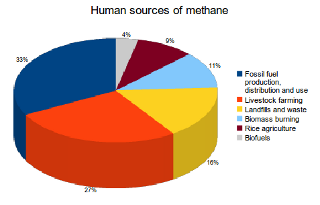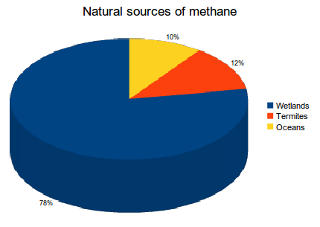There are both natural and human sources of methane emissions. The main natural sources include wetlands, termites and the oceans. Natural sources create 36% of methane emissions. Human sources include landfills and livestock farming. But the most important source being the production, transportation and use of fossil fuels. Human-related sources create the majority of methane emissions, accounting for 64% of the total.
Methane levels have more than doubled over the last 150 years. This is because of human activities like fossil fuel use and intensive farming. Before the Industrial Revolution, natural sinks kept methane levels in a safe range.
Humans are creating methane emissions a lot faster than the Earth can remove them. Which has increased global methane levels. During the last 800,000 years, methane concentrations have always varied between 350-800 ppb. Since the Industrial Revolution, methane levels have become much higher. So much so that they are now 2.5 times larger.
Methane Emissions: Human Sources
Since the Industrial Revolution, human sources of methane emissions have been growing. Fossil fuel production and intensive livestock farming have caused the current increase methane levels. Together these two sources are responsible for 60% of all human methane emissions. Other sources include landfills and waste (16%), biomass burning (11%), rice agriculture (9%) as well as biofuels (4%).
Figure 1: Source: Bousquet, P. et al. (2006). Contribution of anthropogenic and natural sources to atmospheric methane variability.
Source: Bousquet, P. et al. (2006). Contribution of anthropogenic and natural sources to atmospheric methane variability.
Fossil fuel production, distribution and use
The largest human source is from the production, distribution and combustion of fossil fuels. This creates 33% of human methane emissions.
Methane emissions get produced wherever there are fossil fuels. It gets released whenever fossil fuels get extracted from the earth. Whether it is natural gas (which is in most part methane), coal or petroleum. More methane gets released during any type of handling, transportation (pipeline, truck delivery, etc.) or refinement of fossil fuels. Finally some methane is also produced during fossil fuel combustion.
By using fossil fuels, you contribute to the most important source of methane emissions. Fossil fuel production, distribution and use creates 110 million tonnes of methane per year.
A large part of methane emissions get caused by natural gas. Methane is the main component of natural gas. So leakage throughout this industry releases methane straight into the atmosphere. This includes the extraction, processing and transportation of natural gas.
Coal is another important source of methane emissions. In coal formation, pockets of methane get trapped around and within the rock. Coal mining related activities (extraction, crushing, distribution, etc.) release some of this trapped methane. Methane gets emitted from active underground and surface mines as well as abandoned ones.
Oil wells can also have methane deposits that get released during drilling and extraction. The refinement, transportation and storage of oil is also a source of methane emissions.
Incomplete combustion of fossil fuels also produces methane emissions. No combustion process is one hundred percent efficient. So when fossil fuels get used to make electricity, heat or power cars these all produce methane.
Livestock farming
An important source of methane emissions is from enteric fermentation in farm animals. This creates 27% of human methane emissions. Animals like cows, sheep and goats are examples of ruminant animals. During their normal digestion process they create large amounts of methane. Enteric fermentation occurs because of microorganisms in the stomach of these animals. This creates methane as a by-product that is either exhaled by the animal or released via flatus.
Because humans raise these animals for food, their emissions are human-related. This is why the meat that we eat everyday has a huge impact on total methane emissions. Livestock farming creates 90 million tonnes of methane per year.
Livestock related emissions has grown because of the large growth of livestock populations worldwide. Livestock production has seen large growth since the 1960s. With beef production more than doubling during this time.
Landfills and waste
Another important human source of methane emissions is from landfills and waste. Methane gets generated by the decomposition of solid waste in landfills. This also happens with animal and human waste streams. This accounts for 16% of human methane emissions. Landfills and waste produces 55 million tonnes of methane per year.
Landfills and open garbage dumps are full of organic matter. Our garbage contains things like food scraps, newspapers, cut grass and leaves. Every time new garbage comes in it gets pilled over the old garbage that was already there. The organic matter in our garbage gets trapped in conditions where there is no oxygen. This provides excellent conditions for methane producing microbes. They will break down the waste, which produces large amounts of methane emissions. Even after a landfill gets closed, bacteria will continue to decompose the buried waste. Which will emit methane for years.
Wastewater from domestic, municipal and industrial sources can also produce methane emissions. Wastewater can be either released, stored or sent for treatment to remove contaminants. As with landfills, if the decay of organic material in wastewater happens without oxygen then this will create methane.
Livestock farming at even a modest scale will have to manage large amounts of manure daily. This is usually managed by using large waste treatment systems and holding tanks. In many of these systems methane gets produced because they promote anaerobic conditions.
Biomass burning
Biomass burning causes a large amount of methane emissions. Biomass is material from living or dead organic matter. Incomplete burning of biomass creates methane emissions. Huge amounts can get produced during large scale burning. This creates 11% of human methane emissions.
Large open fires get used by humans to destroy crop waste and clear land for agricultural or other uses. Natural wildfires can contribute to this. But the great majority of biomass burning gets caused by human beings. Biomass burning creates 38 million tonnes of methane per year.
Rice agriculture
Another large human source of methane emissions is from rice agriculture. Paddy fields for rice production are man-made wetlands. They have high moisture content, are oxygen depletion and have ample organic material. This creates a great environment for methane producing microbes that decompose the organic matter.
Some of the methane produced gets absorbed by methane-consuming microorganisms. But the vast majority gets released into the atmosphere. Due to the swamp-like environment of rice fields, this crop creates 9% of human methane emissions. Rice agriculture creates 31 million tonnes of methane per year.
Biofuels
Each year biofuels produce 12 million tonnes of methane, making it a significant source. Any biomass used to produce energy for domestic or purposes counts as a biofuel. Incomplete biofuel combustion leads to the production of methane. This creates 4% of human methane emissions.
An estimated 80% of biofuels get used for domestic cooking, heating, and lighting. Often in open cooking fires burning wood, agricultural waste, or animal dung. This is the single largest contributor to global biofuel emissions. Almost half of the world's population, about 2.7 billion people, use solid biofuels to cook and heat their homes on a daily basis. Most are poor, and live in developing countries.
18% of biofuels get used by low technology enterprises such as brick or tile making kilns, restaurants, etc. The balance of the biofuels get consumed for transportation uses.
Methane Emissions: Natural Sources
Methane is also released into the atmosphere by natural processes. Wetlands, termites and the oceans are all natural sources of methane emissions.
The methane produced by natural sources is completely offset by natural methane sinks. This has been so for thousands of years. Before the influence of humans, methane levels were quite steady because of this natural balance. Today, human-related sources create the majority of total methane emissions. This has upset the natural balance that existed before the Industrial Revolution.
Wetlands are an important source of methane. They account for 78% of all natural emissions. Other natural methane sources include termites (12%) and the oceans (10%).
Figure 2: Source: Bousquet, P. et al. (2006). Contribution of anthropogenic and natural sources to atmospheric methane variability.
Source: Bousquet, P. et al. (2006). Contribution of anthropogenic and natural sources to atmospheric methane variability.
Wetlands
Wetlands are the largest natural source of methane. This produces 78% of natural methane emissions. The water-logged conditions of wetlands are perfect for microbes. They need environments with no oxygen and abundant organic matter.
Part of wetland related emissions gets absorbed by methane-consuming microbes. But a large percentage escapes into the atmosphere. Wetlands create 147 million tonnes of methane each year.
Termites
Termites are a significant natural source of methane. During the normal digestion process of a termite, methane gets produced. Termites eat cellulose but rely on micro-organisms in their gut to digest it. These micro-organisms produce methane during the process. This creates 12% of natural methane emissions.
Each termite produces small amounts of methane on a daily basis. But when it gets multiplied by the world population of termites, their emissions add up. Creating a total of 23 million tonnes of methane per year.
Oceans
Another significant natural source of methane comes from the oceans. Methane producing microbes living in the ocean create these emissions. This creates 10% of natural methane emissions. Globally, oceans create 19 million tonnes of methane per year.
Oceanic methane emissions often gets produced in deeper sediment layers of productive coastal areas. This accounts for 75% of the oceans methane emissions. The methane created by these microbes mixes with the surrounding water. After some time it gets emitted to the atmosphere from the ocean surface.
More info:
Methane Emissions - US EPA
What is methane's contribution to global warming? - Skeptical Science
Methane: The other important greenhouse gas - Environmental Defense Fund


